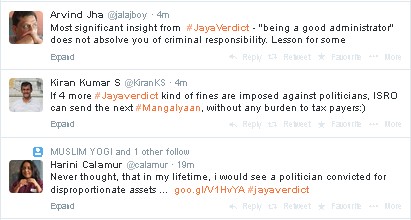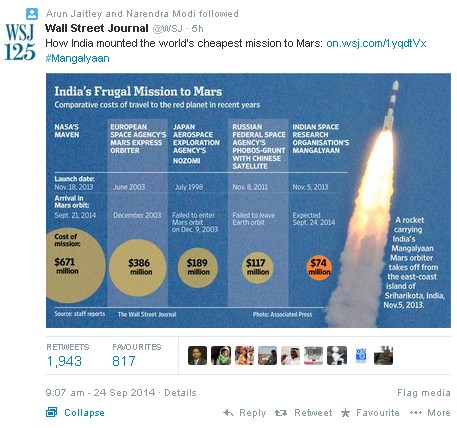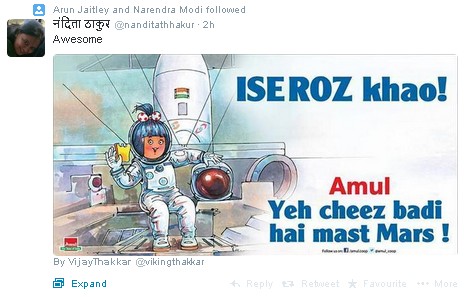
While surfing the internet nowadays, it is commonplace to stumble upon articles classifying a growing right-wing in the country as ‘Internet Hindus’. This term was coined by some well-known journalists and writers in the country who themselves are supposedly ‘Hindus’. According to them, the ‘Internet Hindus’ are trying to alter the secular fabric of the pluralistic Indian society by using the internet as a medium to express their political views. Furthermore, these elite few haven’t refrained from raking up this term in snobbish speeches and articles in foreign news channels and magazines to defame the majority in the country to gain publicity in return.
On the other hand, what we ‘Internet Hindus’ have failed to understand is whether there is something wrong in defending our ancient cultural beliefs while we progress as a united nation to become the world’s most responsible democracy. Yes, we have had a more peaceful history than some of the largest democracies in the world today, because our ancient culture has its roots in teachings of peace and non-violence. Many peaceful religions have been born in a cradle of Hindu culture in ancient India. All of these religions have proven to be much more peaceful than most Abrahamic religions. Moreover, we have always respected all religions and we have co-existed peacefully with everyone. Parsis (native Persians from today’s Iran), Jews, Christians and Muslims have all found refuge in India for centuries amongst native Hindus.
It is also worth noting that the word ‘Hinduism’ was hardly used before the 19th century as a religion. The Persians referred to the region beyond the Indus river as ‘Hindus’, the Persian equivalent of the Sanskrit word Sindhu (for the river Indus). Then the Mughals (Turko-Mongols) who invaded India in the 16th century referred to their kingdom, with Delhi as its capital, as ‘Hindustan’ (or land of Hindus) . Subsequently, the native people of Hindustan came to be known as Hindus. Therefore, ‘Hinduism’ is the culture of native Indians and not a religion in the true sense. The Hindu religious text, the Bhagavad Gita, is an extract from the most famous ancient Indian epic, The Mahabharata. The date of origin of The Mahabharata is not even known but it is often estimated to be during the 8th or 9th century B.C.
Hinduism as a religion was never preached or propagated. Yet, people from other cultural backgrounds have been drawn to Hindu teachings of ‘Karma’ and ‘Dharma’. The essence of Hindu culture lies in these two words. These words simply inculcate one universal belief among adherents of the Hindu culture – ‘What you sow is what you reap’. This means that someone who submits to evil deeds will eventually suffer pain in life or in afterlife while someone who is morally upright with a clear conscience will eventually be rewarded. Nevertheless, the Hindu culture was not free from superstitions and caste systems. But similar superstitions and divisions have been observed in other societies too before the industrial revolutions (for example, the feudal structure prevalent in Europe with kings, nobles, knights, peasants, etc). These have gradually eroded off with technological developments and education.
Today, when we look around our borders, we can see the fate of countries where people have not been able to preserve their own cultural beliefs. Perhaps the two most successful economies in Asia today are China and Japan. National unity could be a key factor behind this. Surprisingly, in China and Japan, a staggering majority of people have held on to their ancient cultural identities instead of taking on divisive identities, irrespective of religion. Nonetheless, China being a large and diverse nation, is also not devoid of separatist movements.
In India, on the other hand, some communities have strictly stuck to intra-religious marriages for girls while Hindus have been more liberal. Some have demanded special quotas in jobs and education sectors on the basis of religion. Pseudo-secular Hindus from political parties have misled the Hindu youth of this country to give in to such demands to gradually increase their own minority vote bank. As a result, some opportunistic political leaders from the minority keep pushing for these extra benefits in the society on the basis of religion at the expense of the liberal Hindu majority. This seems even more unjustified considering that the Hindus haven’t even been a part of the ruling class in India for over 700 years before independence unlike the religions demanding extra benefits. As a result, many Hindus had lost their properties and often succumbed to forced conversions before the formation of India in 1947. Many now live below the poverty line.
The ‘Internet Hindus’ only demand equality in the society and no special benefits for anyone. They only want selections on the basis of merit and oppose political appeasement for the purpose of expanding minority vote banks. It is a well known fact that people from Bangladesh were brought into India illegally and they were helped to get Indian passports on the condition that they would vote for certain political parties. This has changed the demographics in India significantly. This is another thing that ‘Internet Hindus’ have opposed because there aren’t enough jobs for Indian citizens in India today (though Bangladesh is a friendly neighbor with a common language and we have a lot of respect for their people and culture). There is no democracy in the world where a Hindu (or anyone else) would get special concessions for being from a minority religion. At least, in their own country, Hindus do not deserve to be second class citizens.
We are portrayed as extremists just because we want to protect the nation’s secular identity and our own existence before it is too late. But it does not matter how much evidence from history and from today’s global turmoil we put before the pseudo-secular forces, for they will casually say that we are just being paranoid. And then we wonder – ‘Only if our ancestors had been paranoid, then we wouldn’t have to face the tyranny and loot of the likes of Aurangzeb or the British. We would then be a much richer nation today’.
Surprisingly, it is not the ‘Internet Hindus’ who defame Indian minorities or the pseudo-secular groups in front of the international community. It is the other way round! So we would prefer to remain ‘Internet Hindus’ while you carry on your pseudo-secular publicity stunts in the West against the interests of the nation and head on your way to become the Mir Jafars of contemporary India.
Note from the author: This article is not meant to offend anyone. It is meant to be a logical response to critics to explain a growing sentiment within the nation. The author doesn’t endorse those who pose as ‘Internet Hindus’ and use indecent language online instead of presenting a logical argument.
References:
http://ibnlive.in.com/blogs/sagarikaghose/223/64767/in-search-of-the-modern-hindu.html
http://indiatoday.intoday.in/story/social-media-internet-cyber-hindu-twitter-narendra-modi/1/321267.html
http://timesofindia.indiatimes.com/home/stoi/all-that-matters/When-Hinduism-meets-the-internet/articleshow/18097148.cms
http://stream.aljazeera.com/story/201207092020-0022274
http://www.outlookindia.com/article/Who-Milks-This-Cow/282904
















